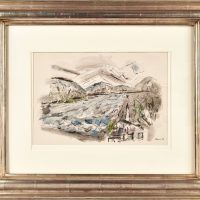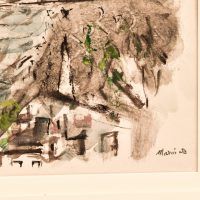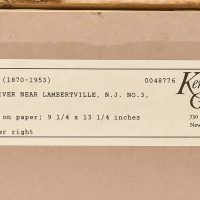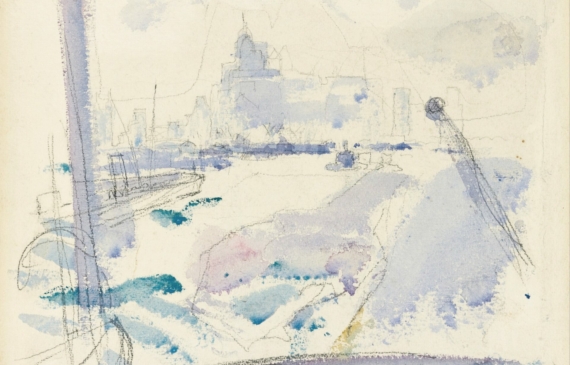



John Marin (American, 1870-1953)
Delaware River Near Lambertville, New Jersey, No. 3, 1950
Watercolor, ink and pencil on paper
9 ¾ H. x 14 W. inches
Signed and dated lower right: Marin ’50
Provenance:
The artist
Estate of the above
Kennedy Galleries, Inc., New York
Doyle, New York, 24 May 2005, Lot 163
Private Collection, New York (probably acquired from the above)
Literature:
S. Reich, John Marin: A Stylistic Analysis and Catalogue Raisonné, vol. II, Tucson, Arizona, 1970, p. 780, no. 50.12, illustrated.
Exhibited:
New York, Kennedy Galleries, Inc., John Marin: Paintings and Watercolors 1940 to 1953, November 4 – 25, 1989, no. 30, illustrated.

John Marin (American, 1870-1953)
View from the Ferry, 1914
Watercolor on paper, 11 H. x 12 ¾ W. inches
Signed and dated lower right
John Marin, an early American modernist closely associated with Alfred Stieglitz, was born and raised in New Jersey. From 1899 to 1901, Marin studied at the Pennsylvania Academy of Fine Arts under Thomas P. Anshutz and Hugh Breckenridge. After spending a few weeks in 1905 at the Art Students League, New York, Marin left for Europe. While in Paris in 1908, he met the photographer Edward Steichen, who referred his work to Alfred Stieglitz, whose gallery in New York was an important showcase for avant-garde art. Impressed, the gallery director visited Marin’s Paris studio, and this encounter led to an exhibition at Stieglitz’s Gallery 291 in New York in 1909.
After Marin returned to America in 1911, he began receiving an annual stipend from Stieglitz that enabled him to concentrate on his painting. In 1913 he exhibited in the Armory Show, and in the following year he discovered the countryside and coastal areas of Maine, thereafter spending his winters in New Jersey and summers in northeastern rural locations. After Stieglitz closed Gallery 291 in 1917, he used his influence to help Marin. His first retrospective was held in 1920 at Daniel Gallery in New York; in 1925 Stieglitz included him in the exhibition of “Seven Americans” held at the Anderson Gallery, New York; and in December of that year Stieglitz opened his second establishment, the Intimate Gallery, with a retrospective of Marin’s work. In early 1926, Duncan Phillips purchased his first works by Marin, and in 1929 he gave the artist his first one-person museum exhibition. After having achieved critical success and recognition over the years, Marin suffered a stroke that claimed his life on October 2, 1953, at Cape Split, Maine, one of his favorite retreats